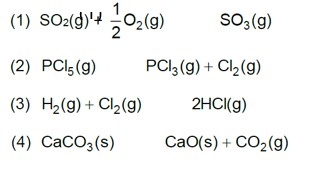Write a relation between ∆G and Q and define the meaning of each term and answer the following :
(a) Why a reaction proceeds forward when Q < K and no net reaction occurs when Q = K.
(b) Explain the effect of increase in pressure in terms of reaction quotient Q. for the reaction :
CO (g) + 3H2 (g)
⇌ CH4 (g) + H2O (g)
Write a relation between ∆G and Q and define the meaning of each term and answer the following :
(a) Why a reaction proceeds forward when Q < K and no net reaction occurs when Q = K.
(b) Explain the effect of increase in pressure in terms of reaction quotient Q. for the reaction :
CO (g) + 3H2 (g) ⇌ CH4 (g) + H2O (g)
-
1 Answer
-
This is a Long Answer Type Questions as classified in NCERT Exemplar
Ans: (a) As we know,
ΔG= ?G? +RTlnQ
?G? = Change in free energy as the reaction proceeds,
ΔG = Standard free energy change,
Q = Reaction quotient,
R = Gas constant,
T = Absolute temperature.
Since, ?G? =−RTlnK
∴ΔG=−RTlnK + RTlnQ = RTlnKQ?
If Q
If Q=K, ΔG=0, reaction is in equilibrium and no net reaction is there.
(b) When we increase the pressure equilibrium will shift in forward direction it means Q
Types of Chemical Reactions :
There are 4 main types of chemical
...more
Similar Questions for you
0.01 M NaOH,
M = 1 * 10-2

pOH = 2
pH = 2
Kp = Kc (RT)Dng
36 * 10–2 = Kc (0.0821 * 300)–1
Kc = 0.36 * 0.0821 * 300 = 8.86 » 9
A(g) ->B(g) + (g)
Initial moles n 0 0
Eqb. moles n(1 – a) na
total moles =
Eqb. pressure
On increasing pressure, equilibrium moves in that direction where number of gaseous moles decreases.
Taking an Exam? Selecting a College?
Get authentic answers from experts, students and alumni that you won't find anywhere else
Sign Up on ShikshaOn Shiksha, get access to
- 66k Colleges
- 1.2k Exams
- 680k Reviews
- 1800k Answers


